-
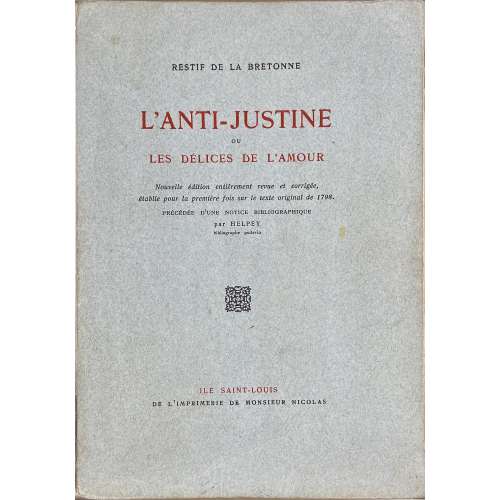 Description: One volume in grey-blue French flapped wrapper, 24 x 16.7 cm, collated 8vo, with black and red lettering to front cover, printed on watermarked thick wove paper Alfax Navarre, margins untrimmed, some pages uncut, illustrated with 12 aquatint plates signed Le Loup. Front wrapper and title (red and black): RESTIF DE LA BRETONNE | L'ANTI-JUSTINE | OU | LES DÉLICES DE L' AMOUR | Nouvelle édition entièrement revue et corrigée, | établie pour la première fois sur le texte original de 1798. | PRÉCÉDÉE D'UNE NOTICE BIBLIOGRAPHIQUE | par HELPEY | bibliographe poitevin | {device} | ILE SAINT-LOUIS | DE L’IMPRIMERIE DE Monsieur Nicolas. Limitation: Printed 350 copies, numbered 1-350, on alfax paper; this copy is № 256. Collation: 1-158 166, incl. the 1st and last leaves within the wrappers, total 126 leaves plus 12 plates extraneous to collation. Pagination: [4 blank] [1-4] 5-243 [244 blank] [4 blank], total 252 pages, ils. Catalogue raisonné: Dutel (1920-1970) № 1025, p. 45. Ref.: Danson Erotica Collection at Trinity College, Oxford – KK.6.33. Contributors: Nicolas Edmé Restif de la Bretonne (French, 1734 – 1806) – author. Louis Perceau [Helpey] (French, 1883 – 1942) – author. Maurice Henri Hector Duflou (French, 1885 – 1951) – publisher. The artist – Le Loup – unidentified.
Description: One volume in grey-blue French flapped wrapper, 24 x 16.7 cm, collated 8vo, with black and red lettering to front cover, printed on watermarked thick wove paper Alfax Navarre, margins untrimmed, some pages uncut, illustrated with 12 aquatint plates signed Le Loup. Front wrapper and title (red and black): RESTIF DE LA BRETONNE | L'ANTI-JUSTINE | OU | LES DÉLICES DE L' AMOUR | Nouvelle édition entièrement revue et corrigée, | établie pour la première fois sur le texte original de 1798. | PRÉCÉDÉE D'UNE NOTICE BIBLIOGRAPHIQUE | par HELPEY | bibliographe poitevin | {device} | ILE SAINT-LOUIS | DE L’IMPRIMERIE DE Monsieur Nicolas. Limitation: Printed 350 copies, numbered 1-350, on alfax paper; this copy is № 256. Collation: 1-158 166, incl. the 1st and last leaves within the wrappers, total 126 leaves plus 12 plates extraneous to collation. Pagination: [4 blank] [1-4] 5-243 [244 blank] [4 blank], total 252 pages, ils. Catalogue raisonné: Dutel (1920-1970) № 1025, p. 45. Ref.: Danson Erotica Collection at Trinity College, Oxford – KK.6.33. Contributors: Nicolas Edmé Restif de la Bretonne (French, 1734 – 1806) – author. Louis Perceau [Helpey] (French, 1883 – 1942) – author. Maurice Henri Hector Duflou (French, 1885 – 1951) – publisher. The artist – Le Loup – unidentified. -
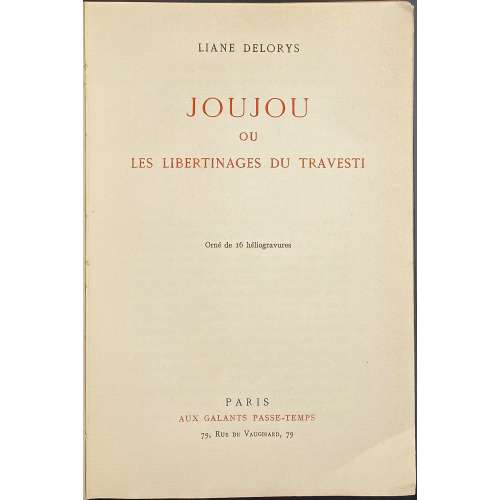 Description: Hardcover, 24.5 x 16.5 cm, collated 8vo, bound in quarter green marbled sheepskin over buckram boards, publisher’s wrappers preserved. Front wrapper and title-page (red and black): LIANE DELORYS | JOUJOU | OU | LES LIBERTINAGES DU TRAVESTI | Orné de 16 héliogravures | PARIS | AUX GALANTS PASSE-TEMPS | 79, Rue de Vaugirard, 79 || Collation: [1]8 (2 blanks, h.t./advert., t.p./limit., text), 2-178 on laid paper (total 136 leaves) plus 16 photomechanical b/w plates, incl. frontispiece on thick wove paper. Pagination: [1-9] 10-269 [3], total 272 pages, ils. Limitation: a print run of 2,050 copies on vergé antique Hollande reserved for subscribers, of which this is copy № 379. Contributors: Author: Liane Delorys – pen name; the real name is unknown; according to various sources other pseudonyms of this author are: Liane Lauré, Liane de Lorys, Liane de Lauris, Lucette de Chata, and G. Donville. The latter may be a real name, though there is no information even about the gender of this person. Publisher: Aux Galants Passe-temps, i.e. Jean Fort or Jean-Marie Fort (French, fl. c. 1907 – 1839), also published under the name of ‘Collection des Orties Blanches’, ‘Bon Vieux temps’, ‘Au Cabinet du Livre’. Artist: Chéri Hérouard (French, 1881 – 1961). Printer: Darantiere (Dijon), i.e. Maurice Darantiere (French, 1882 – 1962).
Description: Hardcover, 24.5 x 16.5 cm, collated 8vo, bound in quarter green marbled sheepskin over buckram boards, publisher’s wrappers preserved. Front wrapper and title-page (red and black): LIANE DELORYS | JOUJOU | OU | LES LIBERTINAGES DU TRAVESTI | Orné de 16 héliogravures | PARIS | AUX GALANTS PASSE-TEMPS | 79, Rue de Vaugirard, 79 || Collation: [1]8 (2 blanks, h.t./advert., t.p./limit., text), 2-178 on laid paper (total 136 leaves) plus 16 photomechanical b/w plates, incl. frontispiece on thick wove paper. Pagination: [1-9] 10-269 [3], total 272 pages, ils. Limitation: a print run of 2,050 copies on vergé antique Hollande reserved for subscribers, of which this is copy № 379. Contributors: Author: Liane Delorys – pen name; the real name is unknown; according to various sources other pseudonyms of this author are: Liane Lauré, Liane de Lorys, Liane de Lauris, Lucette de Chata, and G. Donville. The latter may be a real name, though there is no information even about the gender of this person. Publisher: Aux Galants Passe-temps, i.e. Jean Fort or Jean-Marie Fort (French, fl. c. 1907 – 1839), also published under the name of ‘Collection des Orties Blanches’, ‘Bon Vieux temps’, ‘Au Cabinet du Livre’. Artist: Chéri Hérouard (French, 1881 – 1961). Printer: Darantiere (Dijon), i.e. Maurice Darantiere (French, 1882 – 1962). -
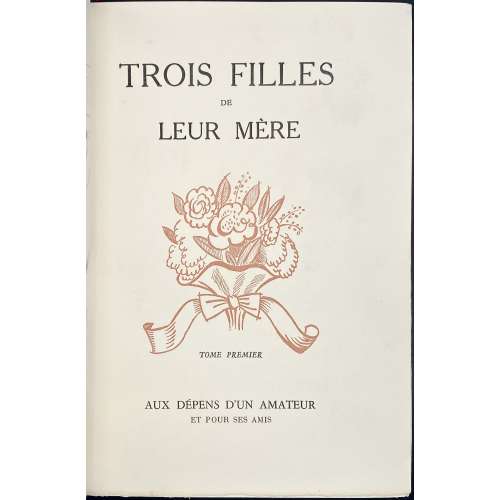 Two softcover volumes bound in one, 28.7 x 20.5 cm, quarter blue morocco over marbled boards, raised bands and gilt lettering to spine, top margin gilt, other untrimmed, marbled endpapers, original covers and spines preserved; 20 full-page etchings by Louis Berthommé Saint-André, incl. 2 frontispieces; vignettes, initials, head- and tailpieces in pink after André Collot. Title-page: TROIS FILLES | DE | LEUR MÈRE | {vignette} | TOME PREMIER (SECOND) | AUX DÉPENS D'UN AMATEUR | ET POUR SES AMIS || Collation: v.1 2ffl, front cover, [1-8] 2 blanks, h.t., t.p., pp. 9-94 [95, 96]; v.2 back cover, spine, front cover, 2 blanks, h.t., t.p., 97-201 [202-4] back cover, spine, 2ffl; plus 20 plates extraneous to collation. Limitation: A print run of 150 copies, of which this is copy № 76. Catalogue raisonné: Dutel III № 2521. As per Dutel, pp: 96+106 (conforms), and the year of 2 vol. publication 1933; however, the etchings are dated to 1926 by many. Contributors: Pierre Louÿs (French, 1870 – 1925) – author. Louis Berthommé Saint-André (French, 1905 – 1977) – artist. André Collot (French, 1897 – 1976) – artist.
Two softcover volumes bound in one, 28.7 x 20.5 cm, quarter blue morocco over marbled boards, raised bands and gilt lettering to spine, top margin gilt, other untrimmed, marbled endpapers, original covers and spines preserved; 20 full-page etchings by Louis Berthommé Saint-André, incl. 2 frontispieces; vignettes, initials, head- and tailpieces in pink after André Collot. Title-page: TROIS FILLES | DE | LEUR MÈRE | {vignette} | TOME PREMIER (SECOND) | AUX DÉPENS D'UN AMATEUR | ET POUR SES AMIS || Collation: v.1 2ffl, front cover, [1-8] 2 blanks, h.t., t.p., pp. 9-94 [95, 96]; v.2 back cover, spine, front cover, 2 blanks, h.t., t.p., 97-201 [202-4] back cover, spine, 2ffl; plus 20 plates extraneous to collation. Limitation: A print run of 150 copies, of which this is copy № 76. Catalogue raisonné: Dutel III № 2521. As per Dutel, pp: 96+106 (conforms), and the year of 2 vol. publication 1933; however, the etchings are dated to 1926 by many. Contributors: Pierre Louÿs (French, 1870 – 1925) – author. Louis Berthommé Saint-André (French, 1905 – 1977) – artist. André Collot (French, 1897 – 1976) – artist. -
 Woodblock print album of thirteen prints, ōban, nishiki-e. Artist: Chōkyōsai Eiri [鳥橋斎 栄里] (Japanese, fl. c. 1789 ~ 1801 ). Models of calligraphy (Fumi no kiyogaki), New Year 1801. This title is taken from Chris Uhlenbeck's Japanese Erotic Fantasies Sexual Imagery of the Edo Period. — Hotei Publishing, 2005, ISBN 90-74822-66-5):. A detailed description of the album can be found at The Complete Ukiyo-e Shunga №9 Eiri, 1996, ISBN 4-309-91019. Most of the edition is in Japanese, though Richard Lane writes a section in English: Eiri: Love-letters, Love Consummated: Fumi-no-kiyogaki. The article starts with the following statement: "Why all the fuss about Sharaku? Because he is so "mysterious"? No, not at all: because he is such a good artist. But Sharaku is not the only great yet enigmatic ukiyo-e artist and I propose to resurrect here one of his important contemporaries who has been all too long neglected: Chōkyōsai Eiri. As with many of the notable ukiyo-e masters, nothing is known of Eiri's biography. All we can say is what we learn from his extant prints and paintings: that he flourished during the second half of the Kansei Period [1789-1801]; and that he was a direct pupil of the great Eishi - who, being of eminent samurai stock, may well have attracted pupils of similar background." Another citation from Japanese Erotic Fantasies: "This album is one of the boldest sets of ōban-size shunga known, The first edition contains thirteen instead of the customary twelve designs". Here I present all thirteen prints, though the edition I bought in Kyoto in 2014 contained only twelve. The thirteenth print was purchased later in the United States (sheet №12).
Woodblock print album of thirteen prints, ōban, nishiki-e. Artist: Chōkyōsai Eiri [鳥橋斎 栄里] (Japanese, fl. c. 1789 ~ 1801 ). Models of calligraphy (Fumi no kiyogaki), New Year 1801. This title is taken from Chris Uhlenbeck's Japanese Erotic Fantasies Sexual Imagery of the Edo Period. — Hotei Publishing, 2005, ISBN 90-74822-66-5):. A detailed description of the album can be found at The Complete Ukiyo-e Shunga №9 Eiri, 1996, ISBN 4-309-91019. Most of the edition is in Japanese, though Richard Lane writes a section in English: Eiri: Love-letters, Love Consummated: Fumi-no-kiyogaki. The article starts with the following statement: "Why all the fuss about Sharaku? Because he is so "mysterious"? No, not at all: because he is such a good artist. But Sharaku is not the only great yet enigmatic ukiyo-e artist and I propose to resurrect here one of his important contemporaries who has been all too long neglected: Chōkyōsai Eiri. As with many of the notable ukiyo-e masters, nothing is known of Eiri's biography. All we can say is what we learn from his extant prints and paintings: that he flourished during the second half of the Kansei Period [1789-1801]; and that he was a direct pupil of the great Eishi - who, being of eminent samurai stock, may well have attracted pupils of similar background." Another citation from Japanese Erotic Fantasies: "This album is one of the boldest sets of ōban-size shunga known, The first edition contains thirteen instead of the customary twelve designs". Here I present all thirteen prints, though the edition I bought in Kyoto in 2014 contained only twelve. The thirteenth print was purchased later in the United States (sheet №12). №1: "...one of the most exotic scenes in all shunga. A Dutch kapitan is discovered coupling with a lovely Japanese courtesan, beside a large window opening upon a garden...".
№1: "...one of the most exotic scenes in all shunga. A Dutch kapitan is discovered coupling with a lovely Japanese courtesan, beside a large window opening upon a garden...".

 №2: "...a fair young harlot is seen masturbating with a grinding-pestle - a man watches intently from under bedding." [I have two specimens of this design; the one from album is more soiled but less faded].
№2: "...a fair young harlot is seen masturbating with a grinding-pestle - a man watches intently from under bedding." [I have two specimens of this design; the one from album is more soiled but less faded].
 №3: "...the artist has effectively contrasted the lovers by depicting the man's face as seen through the geisha's gauze skirt. [...] we are impressed more by strikingly elegant composition, the dramatic coloring, rather than feeling any great urge to participate in the energetic proceedings..."
№3: "...the artist has effectively contrasted the lovers by depicting the man's face as seen through the geisha's gauze skirt. [...] we are impressed more by strikingly elegant composition, the dramatic coloring, rather than feeling any great urge to participate in the energetic proceedings..."
 №4: "This scene is a most straightforward one, featuring the standard Missionary Position [capitalization by R. Lane].; but withal, the contrast of the young and naked, secret lover and the richly-clothed courtesan amid luxurious bedding..."
№4: "This scene is a most straightforward one, featuring the standard Missionary Position [capitalization by R. Lane].; but withal, the contrast of the young and naked, secret lover and the richly-clothed courtesan amid luxurious bedding..."
 №5: "In a striking lesbian scene (which has no equivalent in Utamaro, and is, incidentally, often omitted in later editions of this album), the girl at left prepares to receive the harikata (dildo) worn by the older girl at right (who holds a seashell containing lubricant)."
№5: "In a striking lesbian scene (which has no equivalent in Utamaro, and is, incidentally, often omitted in later editions of this album), the girl at left prepares to receive the harikata (dildo) worn by the older girl at right (who holds a seashell containing lubricant)."
 №6: "In the first appearance of a matronly heroine in this series, we find a widow - with shaven eyebrows and clipped hair - sporting with a handsome yound shop-clerk, mounting him with all her might."
№6: "In the first appearance of a matronly heroine in this series, we find a widow - with shaven eyebrows and clipped hair - sporting with a handsome yound shop-clerk, mounting him with all her might."

 №7: "... lady of samurai court: here, shown taking advantage of an official outing to temple and theatre, to rendezvous with a secret lover on a teahouse balcony." R. Lane considers this design the least successful in the series, especially in comparison with the same theme by Utamaro: "Utamaro female is almost ferocious in her lust for sexual gratification", which does not sound true to me. See Utamaro's sheet №5 from the album Utamakura (歌まくら, Poem of the Pillow) [courtesy The British Museum without permission]:
№7: "... lady of samurai court: here, shown taking advantage of an official outing to temple and theatre, to rendezvous with a secret lover on a teahouse balcony." R. Lane considers this design the least successful in the series, especially in comparison with the same theme by Utamaro: "Utamaro female is almost ferocious in her lust for sexual gratification", which does not sound true to me. See Utamaro's sheet №5 from the album Utamakura (歌まくら, Poem of the Pillow) [courtesy The British Museum without permission]:
 Then, as Richard Lane states, "we are flung suddenly to the bottom rung of Edo society":
Then, as Richard Lane states, "we are flung suddenly to the bottom rung of Edo society":
 №8: "Here we find a fair yotaka ('night-hawk', e.i. streetwalker) accommodating a lusty client in a lumberyard by the bank of the Sumida River".
№8: "Here we find a fair yotaka ('night-hawk', e.i. streetwalker) accommodating a lusty client in a lumberyard by the bank of the Sumida River".
 №9: '... a slightly plump harlot of the lower class receives a night visit from her lover, whose naked form she tries to cover with a cloak."
№9: '... a slightly plump harlot of the lower class receives a night visit from her lover, whose naked form she tries to cover with a cloak."
 №10: "...likely maidservant and lackey - are depicted in bath-room, their passions are all too obviously fired by steaming water."
№10: "...likely maidservant and lackey - are depicted in bath-room, their passions are all too obviously fired by steaming water."
 №11: "...this scene of courtesan and secret lover ranks high not only in Eiri's œuvre but also in the annals of the ukiyo-e genre itself. Both design and colouring are impeccable and, for this period, there is nothing even in the work of great Utamaro that really surpasses it." Again, a doubtful statement, however, this is Utamaro's design for the reader to judge:
№11: "...this scene of courtesan and secret lover ranks high not only in Eiri's œuvre but also in the annals of the ukiyo-e genre itself. Both design and colouring are impeccable and, for this period, there is nothing even in the work of great Utamaro that really surpasses it." Again, a doubtful statement, however, this is Utamaro's design for the reader to judge:
 The last design in my album is this:
The last design in my album is this:
 #13: In most reference books it goes under number 13, and we will assign this number to the sheet. "The final scene of the album features naked participants, probably samurai man and wife. The print is rather subdued in tone and colour, if not in the degree of the passion displayed..."
An additional sheet, acquired separately from a reputable dealer in New York, is usually listed as №12:
#13: In most reference books it goes under number 13, and we will assign this number to the sheet. "The final scene of the album features naked participants, probably samurai man and wife. The print is rather subdued in tone and colour, if not in the degree of the passion displayed..."
An additional sheet, acquired separately from a reputable dealer in New York, is usually listed as №12:
 №12: "One might think that Eiri has reached his peak with the preceding plate 11 - and indeed he has, in both esthetic and erotic terms. But the album is not yet finished, and the next scene lends a needed variety to the series, a slightly comic tableau featuring a middle-aged lackey attempting to forcibly seduce a servant girl of the same domicile". Utamaro's design, that inspired Eiri is here:
№12: "One might think that Eiri has reached his peak with the preceding plate 11 - and indeed he has, in both esthetic and erotic terms. But the album is not yet finished, and the next scene lends a needed variety to the series, a slightly comic tableau featuring a middle-aged lackey attempting to forcibly seduce a servant girl of the same domicile". Utamaro's design, that inspired Eiri is here:
 All descriptions are taken from Richard Lane's article at The Complete Ukiyo-e Shunga №9 Eiri, 1996. He concluded: "...Eiri's erotic series represents a major contribution to shunga art towards the close of ukiyo-e "Golden Age". In part inspired by Utamaro's classic album, this series withal constitutes a unified and original achievement, providing a cumulative effect of gracefully elegant yet glowing eroticism, which remains in the mind's eye long after the pictures themselves are far away."
I only would like to mention here that in several reference sources this album goes under name of Eisho; unfortunately, this mistake is reproduced at www.ukiyo-e.org, which miraculously shows exactly my print, but under the wrong name of the artist. The same mistake can be found at Shunga. The art of love in Japan. Tom and Mary Anne Evans. Paddington Press Ltd., 1975. ISBN 0-8467-0066-2; plates 6.74-6.77: Chōkyōsai Eishō, c. 1800. Even the British Museum edition of 2010 gives the same erroneous attribution: Chōkyōsai Eishō (1793-1801); they provide the following translation of title: "Clean Draft of a Letter" [see: Shunga. Erotic art in Japan. Rosina Buckland. The British Museum Press, 2010; pp. 110-112]. To the honour of the British Museum, I must admit that they have corrected themselves in Shunga. Sex and pleasure in Japanese art. Edited by Timothy Clark, et al. Hotei Publishing, 2013. Now, they say Chōkyōsai Eiri (worked c. 1790s-1801); they also provide a new title: "Neat Version of the Love Letter, or Pure Drawings of Female Beauty". I have already mentioned Richard Lane's version of title: "Love-letters, Love Consummated", and Chris Uhlenbeck's "Models of calligraphy". In poorly designed and printed Shunga. Erotic figures in Japanese art. Presented by Gabriele Mandel. Translated by Alison L'Eplattenier. Crescent Books, New York, 1983, the artist is named Shokyosai Eisho (beginning of the 19th century); title provided: "Models of Calligraphy". Correct attribution to Chōkyōsai Eiri also can be found at Poem of the pillow and other stories by Utamaro, Hokusai, Kuniyoshi and other artists of the floating world. Gian Carlo Calza in collaboration with Stefania Piotti. Phaidon Press, 2010; though the title is translated as "Clean Copy of Female Beauty".
All descriptions are taken from Richard Lane's article at The Complete Ukiyo-e Shunga №9 Eiri, 1996. He concluded: "...Eiri's erotic series represents a major contribution to shunga art towards the close of ukiyo-e "Golden Age". In part inspired by Utamaro's classic album, this series withal constitutes a unified and original achievement, providing a cumulative effect of gracefully elegant yet glowing eroticism, which remains in the mind's eye long after the pictures themselves are far away."
I only would like to mention here that in several reference sources this album goes under name of Eisho; unfortunately, this mistake is reproduced at www.ukiyo-e.org, which miraculously shows exactly my print, but under the wrong name of the artist. The same mistake can be found at Shunga. The art of love in Japan. Tom and Mary Anne Evans. Paddington Press Ltd., 1975. ISBN 0-8467-0066-2; plates 6.74-6.77: Chōkyōsai Eishō, c. 1800. Even the British Museum edition of 2010 gives the same erroneous attribution: Chōkyōsai Eishō (1793-1801); they provide the following translation of title: "Clean Draft of a Letter" [see: Shunga. Erotic art in Japan. Rosina Buckland. The British Museum Press, 2010; pp. 110-112]. To the honour of the British Museum, I must admit that they have corrected themselves in Shunga. Sex and pleasure in Japanese art. Edited by Timothy Clark, et al. Hotei Publishing, 2013. Now, they say Chōkyōsai Eiri (worked c. 1790s-1801); they also provide a new title: "Neat Version of the Love Letter, or Pure Drawings of Female Beauty". I have already mentioned Richard Lane's version of title: "Love-letters, Love Consummated", and Chris Uhlenbeck's "Models of calligraphy". In poorly designed and printed Shunga. Erotic figures in Japanese art. Presented by Gabriele Mandel. Translated by Alison L'Eplattenier. Crescent Books, New York, 1983, the artist is named Shokyosai Eisho (beginning of the 19th century); title provided: "Models of Calligraphy". Correct attribution to Chōkyōsai Eiri also can be found at Poem of the pillow and other stories by Utamaro, Hokusai, Kuniyoshi and other artists of the floating world. Gian Carlo Calza in collaboration with Stefania Piotti. Phaidon Press, 2010; though the title is translated as "Clean Copy of Female Beauty".
-
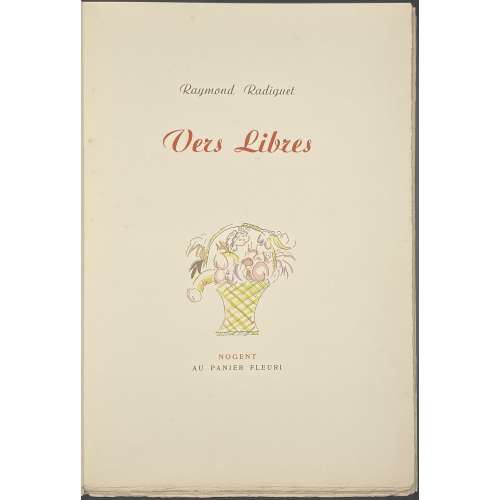 Unbound, unpaginated album (28.4 x 19.5 cm) with 24 leaves (12 folded sheets 28 x 38 cm each), printed on thick wove paper, watermarked Vidalon, with text and 31 vignettes, some pages foxed. Publisher’s original flapped cream wrappers, lettering to front: Raymond Radiguet | Vers Libres | {vignette} || Half-title: “Vers Libres” on a ribbon covering a stick, garland, and flute. Title: Raymond Radiguet | Vers Libres | {vignette} | NOGENT | AU PANIER FLEURI || Illustrations: Cover vignette, frontispiece, tail- and a headpiece for introduction, and vignettes (total 31 illustrations) undoubtedly attributed Rojan (Feodor Rojankovsky). Poems: Chat perché; Champigny, Les fiancés de treize ans, Saison, Le petit journal, Ébauches, Usée, Jeux innocents, Bains publics, L’autre bouche, Cinématographe. In 1937, the «Jeux innocents» piece was added to the 1935 edition, together with 4 illustrations on top of 27 vignettes in 1935, making it 31. Edition: 1st thus; however, the 1935 edition may be considered the 'real' 1st. Limitation on the last page: the total print run on 250 copies by subscription only, this copy is № 181 from 243 on Vélin de Vidalon (as per Dutel). Illustrations printed in black and stencil-coloured (au pochoir). Catalogue raisonné: Dutel 2593; Nordmann (2): 451. Contributors: Raymond Radiguet (French, 1903 – 1923) – author. Feodor Rojankovsky [Rojan; Рожанковский, Фёдор Степанович] (Russian-American, 1891 – 1970) – artist.
Unbound, unpaginated album (28.4 x 19.5 cm) with 24 leaves (12 folded sheets 28 x 38 cm each), printed on thick wove paper, watermarked Vidalon, with text and 31 vignettes, some pages foxed. Publisher’s original flapped cream wrappers, lettering to front: Raymond Radiguet | Vers Libres | {vignette} || Half-title: “Vers Libres” on a ribbon covering a stick, garland, and flute. Title: Raymond Radiguet | Vers Libres | {vignette} | NOGENT | AU PANIER FLEURI || Illustrations: Cover vignette, frontispiece, tail- and a headpiece for introduction, and vignettes (total 31 illustrations) undoubtedly attributed Rojan (Feodor Rojankovsky). Poems: Chat perché; Champigny, Les fiancés de treize ans, Saison, Le petit journal, Ébauches, Usée, Jeux innocents, Bains publics, L’autre bouche, Cinématographe. In 1937, the «Jeux innocents» piece was added to the 1935 edition, together with 4 illustrations on top of 27 vignettes in 1935, making it 31. Edition: 1st thus; however, the 1935 edition may be considered the 'real' 1st. Limitation on the last page: the total print run on 250 copies by subscription only, this copy is № 181 from 243 on Vélin de Vidalon (as per Dutel). Illustrations printed in black and stencil-coloured (au pochoir). Catalogue raisonné: Dutel 2593; Nordmann (2): 451. Contributors: Raymond Radiguet (French, 1903 – 1923) – author. Feodor Rojankovsky [Rojan; Рожанковский, Фёдор Степанович] (Russian-American, 1891 – 1970) – artist. -
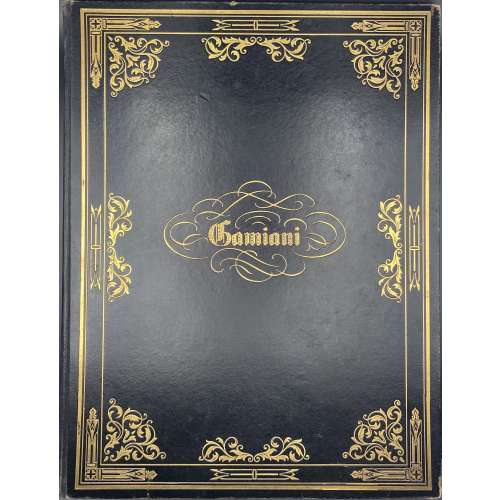 A German translation of de Musset’s “Gamiani ou deux nuits d’excès” illustrated with a reprint title-page and 11 (instead of 16) hand-coloured photogravures after original lithographs by Devéria and Henri Grévedon or Octave Tassaert for 1833 edition, though from the re-drawn stones. Large volume, 40.5 x 31 cm, collated 4to, in black calf with lettering and elaborate gilt border to front and blind border to back, outer and bottom margins uncut, marbled endpapers, text and plates printed on wove paper. The reprint t.p. is different from the original one; in the 1833 edition, the line deux nuits d’excès is waving while here it is straight. Letterpress title-page: ALFRED DE MUSSET | GAMIANI | ODER | ZWEI NÄCHTE DER AUSSCHWEIFUNG || Reprint title-page: Gamiani | OU | DEUX NUITS D’EXCÈS. | {vignette} | Bruxelles | 1833 || Collation: π2 1-74 82, total 32 leaves plus reprint t.p. and 11 plates. Pagination: [4] [1] 2-59 [60], total 64 pages, ils. Limitation: Edition limited to 300 numbered copies, of which this is copy № 32. Contributors: Alfred de Musset (French, 1810 – 1857) – author. Karl Spieler (German, 19th/20th century) – author of the foreword and translator. Achille Devéria (French, 1800 – 1857) – artist (attributed). Pierre Louis Henri Grévedon (French, 1776 – 1860) – artist (attributed). Octave Tassaert (French, 1800 – 1874) – artist (attributed). Catalogue raisonné: Dutel (1650-1880) № A-460, p. 149; Eros invaincu № 68, p. 171-3.
A German translation of de Musset’s “Gamiani ou deux nuits d’excès” illustrated with a reprint title-page and 11 (instead of 16) hand-coloured photogravures after original lithographs by Devéria and Henri Grévedon or Octave Tassaert for 1833 edition, though from the re-drawn stones. Large volume, 40.5 x 31 cm, collated 4to, in black calf with lettering and elaborate gilt border to front and blind border to back, outer and bottom margins uncut, marbled endpapers, text and plates printed on wove paper. The reprint t.p. is different from the original one; in the 1833 edition, the line deux nuits d’excès is waving while here it is straight. Letterpress title-page: ALFRED DE MUSSET | GAMIANI | ODER | ZWEI NÄCHTE DER AUSSCHWEIFUNG || Reprint title-page: Gamiani | OU | DEUX NUITS D’EXCÈS. | {vignette} | Bruxelles | 1833 || Collation: π2 1-74 82, total 32 leaves plus reprint t.p. and 11 plates. Pagination: [4] [1] 2-59 [60], total 64 pages, ils. Limitation: Edition limited to 300 numbered copies, of which this is copy № 32. Contributors: Alfred de Musset (French, 1810 – 1857) – author. Karl Spieler (German, 19th/20th century) – author of the foreword and translator. Achille Devéria (French, 1800 – 1857) – artist (attributed). Pierre Louis Henri Grévedon (French, 1776 – 1860) – artist (attributed). Octave Tassaert (French, 1800 – 1874) – artist (attributed). Catalogue raisonné: Dutel (1650-1880) № A-460, p. 149; Eros invaincu № 68, p. 171-3. -
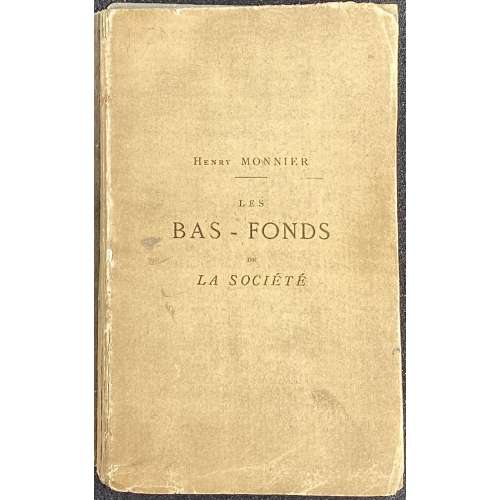 Small softcover volume, ‘édition minuscule’ in-32, 13 x 8 cm, publisher’s wrappers, pp.: [1-6] (h.t., t.p., advert.), [7] 8-160 [2 table/blank], included in pagination 8 pasted etchings on India paper after Félicien Rops and one blank leaf next to plate 1; laid paper with watermarks, some pages uncut. Title-page: DOCUMENTS | POUR SERVIR A L’HISTOIRE DE NOS MŒURS | – | LES | BAS-FONDS | DE LA SOCIÉTÉ | PAR | HENRY MONNIER | AVEC | 8 dessins à la plume | de F. R. | {fleuron} | ÉDITION MINUSCULE | tirée | à 64 exemplaires. || Pencil handwriting on top: 8 gravures de Felicien Rops | 250 –, in the bottom: [1879]. Print run: 64 copies; clandestine edition. Catalogue raisonné: Vicaire V, 1019; Bory p. 100 (though here is the frontispiece for Les Bas-fonds de la société par Joseph Prudhomme [Henry Monnier], 1864, with all the sheets together; Dutel I, A-134. Ref: (1) Poulet-Malassis & ses amis № 90 [LIB-3118.2022] ; (2) Félicien Rops: L'oeuvre graphique complète. / Ouvrage établi et présenté par Jean-François Bory. Avec un texte contemporain de l'artiste par J. K. Huysmans. — Arthur Hubschmidt, 1977. [LIB-2241.2019] Contributors: Henry Monnier (French, 1799 – 1877) – author. Félicien Rops (Belgian, 1833 – 1898) – artist. Henry Kistemaeckers (Belgian, 1851 – 1934) – publisher. Auguste Poulet-Malassis (French, 1825 – 1878)
Small softcover volume, ‘édition minuscule’ in-32, 13 x 8 cm, publisher’s wrappers, pp.: [1-6] (h.t., t.p., advert.), [7] 8-160 [2 table/blank], included in pagination 8 pasted etchings on India paper after Félicien Rops and one blank leaf next to plate 1; laid paper with watermarks, some pages uncut. Title-page: DOCUMENTS | POUR SERVIR A L’HISTOIRE DE NOS MŒURS | – | LES | BAS-FONDS | DE LA SOCIÉTÉ | PAR | HENRY MONNIER | AVEC | 8 dessins à la plume | de F. R. | {fleuron} | ÉDITION MINUSCULE | tirée | à 64 exemplaires. || Pencil handwriting on top: 8 gravures de Felicien Rops | 250 –, in the bottom: [1879]. Print run: 64 copies; clandestine edition. Catalogue raisonné: Vicaire V, 1019; Bory p. 100 (though here is the frontispiece for Les Bas-fonds de la société par Joseph Prudhomme [Henry Monnier], 1864, with all the sheets together; Dutel I, A-134. Ref: (1) Poulet-Malassis & ses amis № 90 [LIB-3118.2022] ; (2) Félicien Rops: L'oeuvre graphique complète. / Ouvrage établi et présenté par Jean-François Bory. Avec un texte contemporain de l'artiste par J. K. Huysmans. — Arthur Hubschmidt, 1977. [LIB-2241.2019] Contributors: Henry Monnier (French, 1799 – 1877) – author. Félicien Rops (Belgian, 1833 – 1898) – artist. Henry Kistemaeckers (Belgian, 1851 – 1934) – publisher. Auguste Poulet-Malassis (French, 1825 – 1878) -
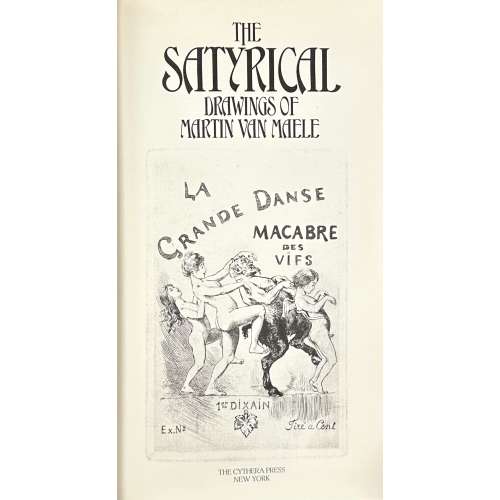 Hardcover volume 28.5 x 19 cm, bound in brown wrinkled buckram with framed gilt lettering and fleurons to front and framed gilt lettering to spine, in a pictorial dust jacket, green and yellow floral diaper endpapers, printed on laid paper, bottom and outer margins untrimmed. Collation: Eight unnumbered pages of text in English, incl. bibliography, plus 45 unnumbered leaves of plates (photomechanical) with captions in French. Facsimile reproduction of the published in ca. 1907-1908 ‘La grande danse macabre des vifs’, which can be loosely translated as ‘The great strange dance of life’ or ‘The great dance of death by the living’. Title-page: THE | SATYRICAL | DRAWINGS OF | MARTIN VAN MAELE | {vignette} | THE CYTHERA PRESS NEW YORK || SELECTED BIBLIOGRAPHY OF MAURICE FRANÇOIS ALFRED MARTIN VAN MAËLE [MARTIN VAN MAËLE] (FRENCH, 1863 – 1926) (ANONYMOUS). Sweet Seventeen. — Paris: Charles Carrington, 1910. ANSON, MARGUERITE. Une Société de flagellantes. — Paris: Charles Carrington. 1902. 31 illustrations by Van Maele and A. Lambrecht. Translation of The Merry Order of St. Bridget. APULEUS, LUCIUS. Les Métamorphoses, ou l’âne d'or. — Paris: Charles Carrington, 1905. Translation of The Golden Ass. The same Van Maele plates were probably used by the publisher for his English translation of the same work (Paris, 1904). ARETINO, PIETRO. Les Dialogues. 2 volumes. — Paris: Au Cabinet du Livre. 1927. Only the textual illustrations are by Van Maele. The other plates are by Viset. This is believed to be the Iast book that Van Maele illustrated. DESROIX, JACQUES. La Gynécocratte. — Paris: Charles Carrington, 1902. Translation of Gynecocracy. FRANCE, ANATOLE. Thaïs. — Paris: Charles Carrington, 1901. English translation. JUSANGE. PIERRE DE. La Comtesse au foulet. — Paris: Collection des Orties Blanches, s.d. SACHER-MASOCH. La Vénus a la fourrure. — Paris: Charles Carrington, 1902. VAN MAELE, MARTIN. La Grande Danse macabre des vifs. — Paris: Charles Carrington, ca. 1907-8. VERLAINE, PAUL. La Trilogie érotique. — Paris: Charles Carrington, 1907. Reprinted, Brussels, 1931. The original edition is rare. VILLIOT, JEAN DE. Camille et moi. — Paris: Charles Carrington, 1904. Translation of Frank and I. VILLIOT, JEAN DE. Dix-sept ans. — Paris: Librairie des Bibliophiles Parisiens, Charles Carrington, 1905. Translation of Sweet Seventeen. VILLIOT, JEAN DE. La Flagellation amoureuse. — Paris: Charles Carrington. 1904. VILLIOT, JEAN DE. La Flagellation des femmes en Allemagne. — Paris: Charles Carrington. 1901. Translation of Nell in Bridewell. VILLIOT, JEAN DE. Volées de bois vert. — Paris: Librairie des Bibliophiles Parisiens, Charles Carrington, 1905. (ANONYMOUS): Flèches de plomb. BAUDELAIRE, CHARLES. Les Fleurs du mal. BERANGER. Chansons érotiques. CHODER LOS DE LACLOS. Les Liaisons dangereuses. — Paris: 1908. GAUTIER, THEOPHILE. Lettre au Président. HARAUCOURT. Légende des sexes. — Paris, 1908. MICHELET, JULES. La Sorcière. — Paris, 1911.
Hardcover volume 28.5 x 19 cm, bound in brown wrinkled buckram with framed gilt lettering and fleurons to front and framed gilt lettering to spine, in a pictorial dust jacket, green and yellow floral diaper endpapers, printed on laid paper, bottom and outer margins untrimmed. Collation: Eight unnumbered pages of text in English, incl. bibliography, plus 45 unnumbered leaves of plates (photomechanical) with captions in French. Facsimile reproduction of the published in ca. 1907-1908 ‘La grande danse macabre des vifs’, which can be loosely translated as ‘The great strange dance of life’ or ‘The great dance of death by the living’. Title-page: THE | SATYRICAL | DRAWINGS OF | MARTIN VAN MAELE | {vignette} | THE CYTHERA PRESS NEW YORK || SELECTED BIBLIOGRAPHY OF MAURICE FRANÇOIS ALFRED MARTIN VAN MAËLE [MARTIN VAN MAËLE] (FRENCH, 1863 – 1926) (ANONYMOUS). Sweet Seventeen. — Paris: Charles Carrington, 1910. ANSON, MARGUERITE. Une Société de flagellantes. — Paris: Charles Carrington. 1902. 31 illustrations by Van Maele and A. Lambrecht. Translation of The Merry Order of St. Bridget. APULEUS, LUCIUS. Les Métamorphoses, ou l’âne d'or. — Paris: Charles Carrington, 1905. Translation of The Golden Ass. The same Van Maele plates were probably used by the publisher for his English translation of the same work (Paris, 1904). ARETINO, PIETRO. Les Dialogues. 2 volumes. — Paris: Au Cabinet du Livre. 1927. Only the textual illustrations are by Van Maele. The other plates are by Viset. This is believed to be the Iast book that Van Maele illustrated. DESROIX, JACQUES. La Gynécocratte. — Paris: Charles Carrington, 1902. Translation of Gynecocracy. FRANCE, ANATOLE. Thaïs. — Paris: Charles Carrington, 1901. English translation. JUSANGE. PIERRE DE. La Comtesse au foulet. — Paris: Collection des Orties Blanches, s.d. SACHER-MASOCH. La Vénus a la fourrure. — Paris: Charles Carrington, 1902. VAN MAELE, MARTIN. La Grande Danse macabre des vifs. — Paris: Charles Carrington, ca. 1907-8. VERLAINE, PAUL. La Trilogie érotique. — Paris: Charles Carrington, 1907. Reprinted, Brussels, 1931. The original edition is rare. VILLIOT, JEAN DE. Camille et moi. — Paris: Charles Carrington, 1904. Translation of Frank and I. VILLIOT, JEAN DE. Dix-sept ans. — Paris: Librairie des Bibliophiles Parisiens, Charles Carrington, 1905. Translation of Sweet Seventeen. VILLIOT, JEAN DE. La Flagellation amoureuse. — Paris: Charles Carrington. 1904. VILLIOT, JEAN DE. La Flagellation des femmes en Allemagne. — Paris: Charles Carrington. 1901. Translation of Nell in Bridewell. VILLIOT, JEAN DE. Volées de bois vert. — Paris: Librairie des Bibliophiles Parisiens, Charles Carrington, 1905. (ANONYMOUS): Flèches de plomb. BAUDELAIRE, CHARLES. Les Fleurs du mal. BERANGER. Chansons érotiques. CHODER LOS DE LACLOS. Les Liaisons dangereuses. — Paris: 1908. GAUTIER, THEOPHILE. Lettre au Président. HARAUCOURT. Légende des sexes. — Paris, 1908. MICHELET, JULES. La Sorcière. — Paris, 1911. -
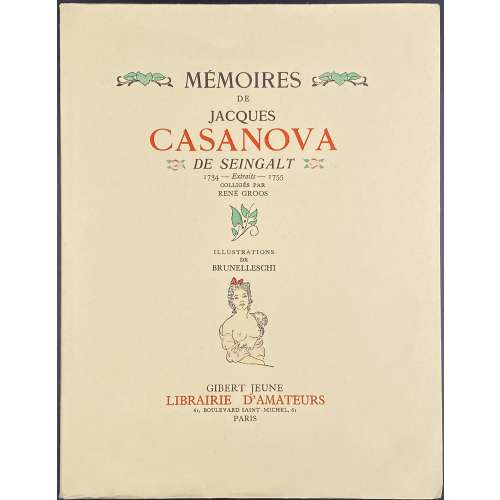 Two-volume set. MÉMOIRES | DE | JACQUES | CASANOVA | DE SEINGALT | 1734 — Extraits — 1755 | COLLIGÉS PAR | RÉNE GROOS | ILLUSTRATIONS | DE | BRUNELLESCHI | {vignette} | GIBERT JEUNE | LIBRAIRIE D’AMATEURS | 61, BOULEVARD DE SAINT-MICHEL, 61 | PARIS || Pagination: [6], 1-345 [346], [8]; frontispiece and 15 colour plates (collotype), b/w tail-pieces and vignettes (offset). MÉMOIRES | DE | JACQUES | CASANOVA | DE SEINGALT | 1755 — Extraits — 1772 | COLLIGÉS PAR | RÉNE GROOS | ILLUSTRATIONS | DE | BRUNELLESCHI | {vignette} | GIBERT JEUNE | LIBRAIRIE D’AMATEURS | 61, BOULEVARD DE SAINT-MICHEL, 61 | PARIS || Pagination: [6] 1-337 [348] [8]; frontispiece and 15 colour plates (collotype), b/w tail-pieces and vignettes (offset). Limited edition, №2507 of 3000. Binding: original tan pictorial wrappers, in a slipcase.
Two-volume set. MÉMOIRES | DE | JACQUES | CASANOVA | DE SEINGALT | 1734 — Extraits — 1755 | COLLIGÉS PAR | RÉNE GROOS | ILLUSTRATIONS | DE | BRUNELLESCHI | {vignette} | GIBERT JEUNE | LIBRAIRIE D’AMATEURS | 61, BOULEVARD DE SAINT-MICHEL, 61 | PARIS || Pagination: [6], 1-345 [346], [8]; frontispiece and 15 colour plates (collotype), b/w tail-pieces and vignettes (offset). MÉMOIRES | DE | JACQUES | CASANOVA | DE SEINGALT | 1755 — Extraits — 1772 | COLLIGÉS PAR | RÉNE GROOS | ILLUSTRATIONS | DE | BRUNELLESCHI | {vignette} | GIBERT JEUNE | LIBRAIRIE D’AMATEURS | 61, BOULEVARD DE SAINT-MICHEL, 61 | PARIS || Pagination: [6] 1-337 [348] [8]; frontispiece and 15 colour plates (collotype), b/w tail-pieces and vignettes (offset). Limited edition, №2507 of 3000. Binding: original tan pictorial wrappers, in a slipcase. -
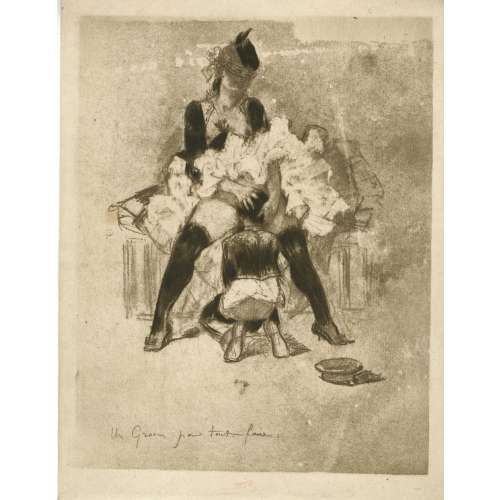
Etching on laid paper, depicting a kneeling groom with his head between the spread legs of a bare-breasted woman in a veiled hat. Inscribed on plate: Un groom a tout faire. Owner's stamp LVM on verso.
Dimensions: Paper: 24.4 x 15.8 cm; Image: 12 x 7.5 cm
Catalogue raisonné: Arthur Hubschmid (1977): 662.
-
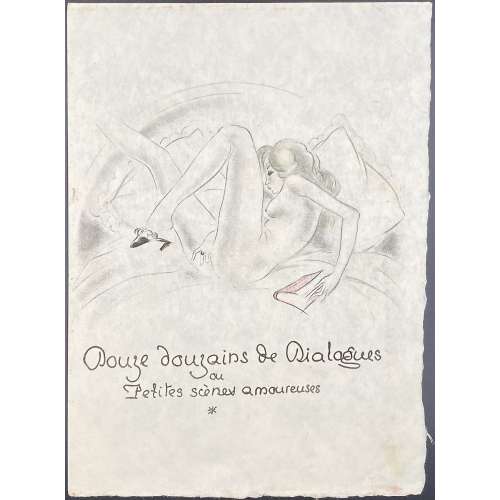 Description: An unbound softcover volume 23.5 x 18 cm collated in 4to, text in fac-simile manuscript printed on Japon Nacre wove paper with untrimmed outer and bottom margins, with 12 laid-in hand-coloured etchings, including the title-page, after André Collot; in red quarter morocco over marbled boards folder with gilt lettering to spine “P. L. | ~ | PETITES | SCÈNES | AMOUREUSES”, in a red faux ostrich leather clamshell box 26.7 x 21 cm. A copy without the limitation page. Title-page: {vignette in colour} | Douze douzains de Dialogues | ou | Petites scènes amoureuses | * || (text in fac-simile ms). Content: (97 dialogues, not 144), similar to Pia: Premier douzain : Dialogues des Filles nues (1, 3, 4, 5, 6) – 5 dialogues; Deuxième douzain : Dialogue[s] des Masturbées (13, 14, 15, 16, 17, 18, 19, 20, [21]) – 9 dialogues; Troisième douzain : Dialogues des Masturbées (25, 26, 27, [28], 29, 30, 31, 32, 33) – 9 dialogues; Quatrième douzain : Dialogues des Lécheuses (37, 38, 39, 40, 41, 42, 44) – 7 dialogues; Cinquième douzain : Dialogues des Phallophores (49, 50, 51, 52, 53, 54) – 6 dialogues; Sixième douzain : Dialogues des Goules (61, 62, 63, 64, 65, 65 (i.e. 66), 67, 68, 69, 70, 71) – 11 dialogues; Septième douzain : Dialogues des Amoureuses (73, 74, 75, 76, 77, 78, 79, [80]) – 8 dialogues; Huitième douzain : Dialogues des Enculées (85, 86, 87, 88, 89, 90, 91, 92, 93, 94, [95]) – 11 dialogues; Neuvième douzain : Dialogues des Chieuses (97, 98, 99, 100, 101, 102, 104) – 7 dialogues; Dixième douzain : Dialogues des Pisseuses (109, 110, 111, 112, 114) – 5 dialogues; Onzième douzain : Dialogues des Mères (121, 122, 123, 124, 125, 126, 127, 128, 129, 130, 131, 132) – 12 dialogues; Douzième douzain : Dialogues des Enfants (134, 135, 136, 137, 138, 139, [140]) – 7 dialogues. Collation: unpaginated, unbound [1]2 [16]4; total 66 leaves plus 12 plates, incl. t.p. In reality, when compared with another copy of the same book [LIB-3144.2023], the first gathering should have consisted of four leaves: 11 blanks, 12 engraved t.p. / blank, 13 blank / limitation, 14 faux t.p. Premier Douzain Dialogues des Filles nues. Edition: This copy of "calligraphié" Douze douzains de dialogues ou petites scènes amoureuses was most probably published in Paris by Libraire Robert Télin in 1927, 100 copies on Japon Nacre as per Dutel (1920-1970) № 1427. However, per Dutel (1) the title-page lettering is all in capital letters, (2) the illustration printed on p. 545 differs from the one in my copy, (3) the number of leaves is 68, while in my copy it is 66. Another "calligraphié" edition published in c. 1940 (Dutel 1429) is bound and has 80 leaves. Dutel unequivocally attributes the drawings to André Collot. Plates in this copy are similar to the ones in a pirated copy of Scènes de péripatéticiennes / Douze douzains de dialogues [LIB-2961.2022] (Dutel № 2366). According to Pia (1978) № 358, this is a 1927 edition published in Paris by libraire Robert Télin: « 1 f. blanc, 1 f. (justification), 1 f. (titre) et 65 ff. n. ch., plus 11 gravures à l’eau-forte rehaussées de couleurs ». Pia describes the folder and the box (chemise et étui) with lettering to spine almost as in my case: “P. L. | – | Petites | scènes | amoureuses” (lower case). Per Pia, illustrations are after André Collot (French, 1897 – 1976) or Louis Berthomme Saint-André (French, 1905 – 1977). Edition limited to 100 copies numbered I – C. There is no limitation statement in my copy, which may explain why my copy has fewer leaves than per Dutel and Pia. Catalogue raisonné: Dutel (1920-1970) №№ 1427 and 1429, p. 137 and № 2366, p. 356 ; Pia (1978) 358-9, p. 199-200. Contributors: Pierre Louÿs (French, 1870 – 1925) – author. André Collot (French, 1897 – 1976) – artist.
Description: An unbound softcover volume 23.5 x 18 cm collated in 4to, text in fac-simile manuscript printed on Japon Nacre wove paper with untrimmed outer and bottom margins, with 12 laid-in hand-coloured etchings, including the title-page, after André Collot; in red quarter morocco over marbled boards folder with gilt lettering to spine “P. L. | ~ | PETITES | SCÈNES | AMOUREUSES”, in a red faux ostrich leather clamshell box 26.7 x 21 cm. A copy without the limitation page. Title-page: {vignette in colour} | Douze douzains de Dialogues | ou | Petites scènes amoureuses | * || (text in fac-simile ms). Content: (97 dialogues, not 144), similar to Pia: Premier douzain : Dialogues des Filles nues (1, 3, 4, 5, 6) – 5 dialogues; Deuxième douzain : Dialogue[s] des Masturbées (13, 14, 15, 16, 17, 18, 19, 20, [21]) – 9 dialogues; Troisième douzain : Dialogues des Masturbées (25, 26, 27, [28], 29, 30, 31, 32, 33) – 9 dialogues; Quatrième douzain : Dialogues des Lécheuses (37, 38, 39, 40, 41, 42, 44) – 7 dialogues; Cinquième douzain : Dialogues des Phallophores (49, 50, 51, 52, 53, 54) – 6 dialogues; Sixième douzain : Dialogues des Goules (61, 62, 63, 64, 65, 65 (i.e. 66), 67, 68, 69, 70, 71) – 11 dialogues; Septième douzain : Dialogues des Amoureuses (73, 74, 75, 76, 77, 78, 79, [80]) – 8 dialogues; Huitième douzain : Dialogues des Enculées (85, 86, 87, 88, 89, 90, 91, 92, 93, 94, [95]) – 11 dialogues; Neuvième douzain : Dialogues des Chieuses (97, 98, 99, 100, 101, 102, 104) – 7 dialogues; Dixième douzain : Dialogues des Pisseuses (109, 110, 111, 112, 114) – 5 dialogues; Onzième douzain : Dialogues des Mères (121, 122, 123, 124, 125, 126, 127, 128, 129, 130, 131, 132) – 12 dialogues; Douzième douzain : Dialogues des Enfants (134, 135, 136, 137, 138, 139, [140]) – 7 dialogues. Collation: unpaginated, unbound [1]2 [16]4; total 66 leaves plus 12 plates, incl. t.p. In reality, when compared with another copy of the same book [LIB-3144.2023], the first gathering should have consisted of four leaves: 11 blanks, 12 engraved t.p. / blank, 13 blank / limitation, 14 faux t.p. Premier Douzain Dialogues des Filles nues. Edition: This copy of "calligraphié" Douze douzains de dialogues ou petites scènes amoureuses was most probably published in Paris by Libraire Robert Télin in 1927, 100 copies on Japon Nacre as per Dutel (1920-1970) № 1427. However, per Dutel (1) the title-page lettering is all in capital letters, (2) the illustration printed on p. 545 differs from the one in my copy, (3) the number of leaves is 68, while in my copy it is 66. Another "calligraphié" edition published in c. 1940 (Dutel 1429) is bound and has 80 leaves. Dutel unequivocally attributes the drawings to André Collot. Plates in this copy are similar to the ones in a pirated copy of Scènes de péripatéticiennes / Douze douzains de dialogues [LIB-2961.2022] (Dutel № 2366). According to Pia (1978) № 358, this is a 1927 edition published in Paris by libraire Robert Télin: « 1 f. blanc, 1 f. (justification), 1 f. (titre) et 65 ff. n. ch., plus 11 gravures à l’eau-forte rehaussées de couleurs ». Pia describes the folder and the box (chemise et étui) with lettering to spine almost as in my case: “P. L. | – | Petites | scènes | amoureuses” (lower case). Per Pia, illustrations are after André Collot (French, 1897 – 1976) or Louis Berthomme Saint-André (French, 1905 – 1977). Edition limited to 100 copies numbered I – C. There is no limitation statement in my copy, which may explain why my copy has fewer leaves than per Dutel and Pia. Catalogue raisonné: Dutel (1920-1970) №№ 1427 and 1429, p. 137 and № 2366, p. 356 ; Pia (1978) 358-9, p. 199-200. Contributors: Pierre Louÿs (French, 1870 – 1925) – author. André Collot (French, 1897 – 1976) – artist. -
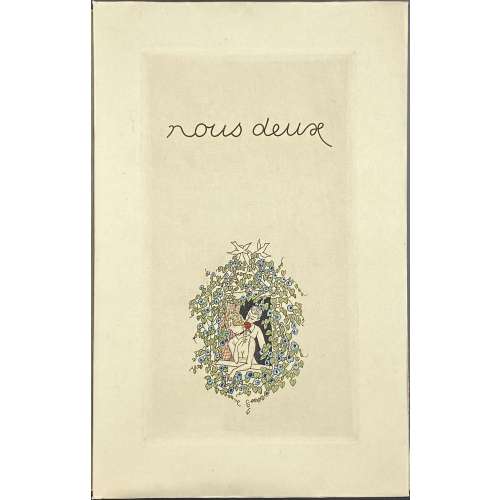 Description: Two volumes 23.1 x 14.9 cm each, collated in 4to, uniformly bound in French flapped wrappers with the title and an engraved vignette, coloured; wrapped in glassine; cased in a cardboard chemise (23.1 x 15 cm) with a diaper of two hearts pierced by an arrow, in pink; and both volumes cased in a slipcase (23.8 x 15.2 cm) with the same diaper. Printed on unpaginated dense wove paper watermarked ‘Arches’, engravings with clear plate marks. Illustrations are by Jean Dulac. Title-page (double-fillet frame, black and red in manuscript) Nelly et Jean | – | nous deux | simples | papiers | du| tiroir secret | {vignette} | Première partie (Deuxième partie) | – | Gravé | et imprimé | pour les auteurs | et leurs amis || Vol. 1: 1 blank, π4 (blank, h.t., frontis., engr. t.p.), 1-84, [2 blanks]; total 39 leaves with 19 hand-coloured burin engravings, incl. wrapper, frontis., and t.p. Unpag. Vol. 2: 1 blank, π4 (blank, h.t., frontis., engr. t.p.), 1-114, [1 colophon] [2 blanks], total 52 leaves with 27 hand-coloured burin engravings, incl. wrapper, frontis., and t.p. Unpag. Limitation: total print run of 295 copies of which 12 (№№ 1-12) on Japon Impérial, 13 on Vélin d’Arches (№№ 13-25), 30 on Japon Impérial (№№ 26-55) and 240 on Vélin d’Arches (№№ 56-295); this is copy № 97 on Vélin d’Arches. Contributors: Marcel Valotaire (French, 1889 – 1979) – author. Jean Dulac (French, 1902 – 1968) – artist. Printed by Coulouma (Argenteuil) and Vernant (Paris). The same title with illustrations by Gaston de Sainte-Croix was published in 1956: LIB-2880.2021.
Description: Two volumes 23.1 x 14.9 cm each, collated in 4to, uniformly bound in French flapped wrappers with the title and an engraved vignette, coloured; wrapped in glassine; cased in a cardboard chemise (23.1 x 15 cm) with a diaper of two hearts pierced by an arrow, in pink; and both volumes cased in a slipcase (23.8 x 15.2 cm) with the same diaper. Printed on unpaginated dense wove paper watermarked ‘Arches’, engravings with clear plate marks. Illustrations are by Jean Dulac. Title-page (double-fillet frame, black and red in manuscript) Nelly et Jean | – | nous deux | simples | papiers | du| tiroir secret | {vignette} | Première partie (Deuxième partie) | – | Gravé | et imprimé | pour les auteurs | et leurs amis || Vol. 1: 1 blank, π4 (blank, h.t., frontis., engr. t.p.), 1-84, [2 blanks]; total 39 leaves with 19 hand-coloured burin engravings, incl. wrapper, frontis., and t.p. Unpag. Vol. 2: 1 blank, π4 (blank, h.t., frontis., engr. t.p.), 1-114, [1 colophon] [2 blanks], total 52 leaves with 27 hand-coloured burin engravings, incl. wrapper, frontis., and t.p. Unpag. Limitation: total print run of 295 copies of which 12 (№№ 1-12) on Japon Impérial, 13 on Vélin d’Arches (№№ 13-25), 30 on Japon Impérial (№№ 26-55) and 240 on Vélin d’Arches (№№ 56-295); this is copy № 97 on Vélin d’Arches. Contributors: Marcel Valotaire (French, 1889 – 1979) – author. Jean Dulac (French, 1902 – 1968) – artist. Printed by Coulouma (Argenteuil) and Vernant (Paris). The same title with illustrations by Gaston de Sainte-Croix was published in 1956: LIB-2880.2021. -
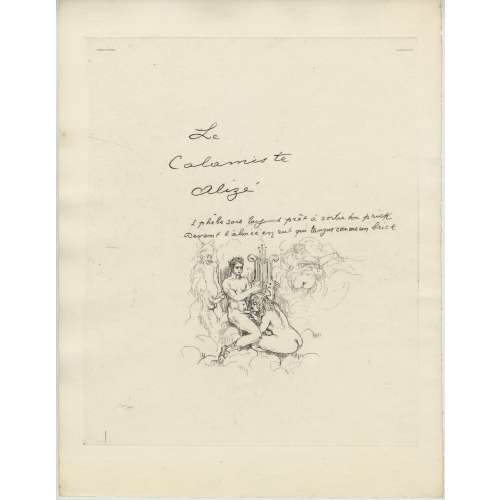 Thirteen unnumbered loose leaves 323 x 249 mm, watermarked BFK Rives, with manuscript text and vignettes produced by etching or, more likely, drypoint (see microphoto), incl. title-page, one full-page illustration and two leaves of text only; versos blank. Some leaves have registration marks. The set is housed in a cream French flapped folder (chemise) without lettering; the seller’s description is pasted to the front cover verso, glassine dust cover. Seller’s description: Cette édition in-folio du recueil de poèmes de Louis de Gonzague Frick, inconnue de Jean-Pierre Dutel, qui « a été tirée à 50 exemplaires (...) est certainement la plus rare (et a été) publiée après 1940 sur vélin (BFK) Rives » (cf. Ader, 3 mars 2020, n°155). Exemplaire « de passe », sans justificatif, complet des 13 planches avec 11 eaux-fortes, dont une à pleine page, d'Auguste Brouet. Ref.: According to honesterotica, the first edition was published in 1938 in 65 copies: "The pink Ingres paper and the loose-leaf format tied with a red ribbon". Another source states: "Le tirage a été effectué avec marges, sur papier vélin BFK Rives au format in-4 (32,5 × 25), les planches mesurant 26,5 × 22 cm. Certains exemplaires sont sur papier blanc - Je remercie le libraire qui a pris la peine de me communiquer ces dernières informations. Pour moi, c'est bien l'édition à 65 qui est l'originale, les deux autres étant des retirages légèrement postérieurs, mais dans le détail desquels le principe de l’œuvre - un manuscrit destiné à quelques amis de l'auteur - a été quelque peu trahi." Contributors: Louis de Gonzague Frick (French, 1883 – 1958) Auguste Brouet (French, 1872 – 1941)
Thirteen unnumbered loose leaves 323 x 249 mm, watermarked BFK Rives, with manuscript text and vignettes produced by etching or, more likely, drypoint (see microphoto), incl. title-page, one full-page illustration and two leaves of text only; versos blank. Some leaves have registration marks. The set is housed in a cream French flapped folder (chemise) without lettering; the seller’s description is pasted to the front cover verso, glassine dust cover. Seller’s description: Cette édition in-folio du recueil de poèmes de Louis de Gonzague Frick, inconnue de Jean-Pierre Dutel, qui « a été tirée à 50 exemplaires (...) est certainement la plus rare (et a été) publiée après 1940 sur vélin (BFK) Rives » (cf. Ader, 3 mars 2020, n°155). Exemplaire « de passe », sans justificatif, complet des 13 planches avec 11 eaux-fortes, dont une à pleine page, d'Auguste Brouet. Ref.: According to honesterotica, the first edition was published in 1938 in 65 copies: "The pink Ingres paper and the loose-leaf format tied with a red ribbon". Another source states: "Le tirage a été effectué avec marges, sur papier vélin BFK Rives au format in-4 (32,5 × 25), les planches mesurant 26,5 × 22 cm. Certains exemplaires sont sur papier blanc - Je remercie le libraire qui a pris la peine de me communiquer ces dernières informations. Pour moi, c'est bien l'édition à 65 qui est l'originale, les deux autres étant des retirages légèrement postérieurs, mais dans le détail desquels le principe de l’œuvre - un manuscrit destiné à quelques amis de l'auteur - a été quelque peu trahi." Contributors: Louis de Gonzague Frick (French, 1883 – 1958) Auguste Brouet (French, 1872 – 1941) -
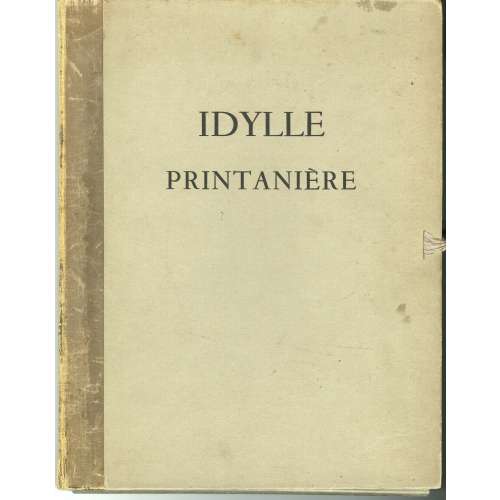 Title: IDYLLE | PRINTANIÈRE || Verso: {Headpiece} | Justification du tirage | {7 lines of text} | Exemplaire № 56 (digits by hand) | HP (monogram by hand) | {tailpiece} || Album of 30 hand-coloured lithographs and frontispiece in a cardboard folder; each sheet mounted in a 32.5 x 25 cm passepartout with 19 x 13 cm window; published in Paris in 1938 by Henri Pasquinelli (attributed). No artist, no publisher name indicated. According to Justification du tirage, the print run of 516 copies on Arches laid tinted paper (vergé), copy A – control artist’s uncoloured, 15 copies B–P reserved for collaborators and friends, copies 1–500 – for bibliophiles. This copy № 56, autographed by the publisher's monogram: "HP". Catalogue Raisonné: J.-P. Dutel, vol 2 (1920–1970), #1726, p. 207-8. Provenance: J.-P. Dutel.
Title: IDYLLE | PRINTANIÈRE || Verso: {Headpiece} | Justification du tirage | {7 lines of text} | Exemplaire № 56 (digits by hand) | HP (monogram by hand) | {tailpiece} || Album of 30 hand-coloured lithographs and frontispiece in a cardboard folder; each sheet mounted in a 32.5 x 25 cm passepartout with 19 x 13 cm window; published in Paris in 1938 by Henri Pasquinelli (attributed). No artist, no publisher name indicated. According to Justification du tirage, the print run of 516 copies on Arches laid tinted paper (vergé), copy A – control artist’s uncoloured, 15 copies B–P reserved for collaborators and friends, copies 1–500 – for bibliophiles. This copy № 56, autographed by the publisher's monogram: "HP". Catalogue Raisonné: J.-P. Dutel, vol 2 (1920–1970), #1726, p. 207-8. Provenance: J.-P. Dutel. -
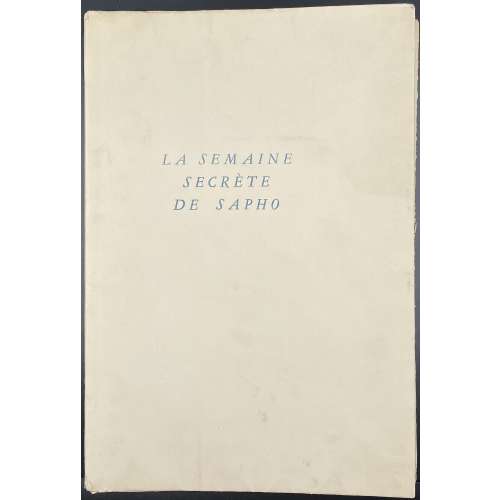 Description: One volume in cream French flapped wrappers, 28.5 x 19.5 cm, lettered to front in blue, printed on wove paper, [1-8] 9-157 [158] [6 blanks] + 8 plates tipped-in; total 82 leaves, first two and last three blank (total 8 blanks), the first and last leaves in the wrappers. Clandestine pirate edition with 8 collotype reproductions of coloured etchings after André Collot. Some plates with a water stain in the upper left corner, one plate has a long closed tear along the left margin. Compare to the original etchings, these plates look dull. Front wrapper (blue): LA SEMAINE | SECRÈTE | DE SAPHO || Title-page (black): LA SEMAINE | SECRÈTE | DE SAPHO | Illustrée de huit gravures | coloriées à la main | LA CHRONIQUE DES DAMES | CONTEMPORAINES || Limitation: The run of 300 copies printed on vélin de luxe “illustrée de huit gravures avec remarques colorées à la main”. This copy is № 128. Note: According to J.-P. Dutel (1920-1970) № 2385, p. 360, it is a pirate edition, printed in c. 1930. Jean-Pierre does not indicate that the plates are collotype reproductions, however, it is obvious when assessed under a microscope with a magnification of 60. The original edition published in 1929 has a different title-page and is illustrated with hand-coloured etchings, see Dutel (1920-1970) № 2384, p. 360. Contributors: Pascal Pia [Pierre Durand] (French, 1903 – 1979) – author. André Collot (French, 1897 – 1976) – artist.
Description: One volume in cream French flapped wrappers, 28.5 x 19.5 cm, lettered to front in blue, printed on wove paper, [1-8] 9-157 [158] [6 blanks] + 8 plates tipped-in; total 82 leaves, first two and last three blank (total 8 blanks), the first and last leaves in the wrappers. Clandestine pirate edition with 8 collotype reproductions of coloured etchings after André Collot. Some plates with a water stain in the upper left corner, one plate has a long closed tear along the left margin. Compare to the original etchings, these plates look dull. Front wrapper (blue): LA SEMAINE | SECRÈTE | DE SAPHO || Title-page (black): LA SEMAINE | SECRÈTE | DE SAPHO | Illustrée de huit gravures | coloriées à la main | LA CHRONIQUE DES DAMES | CONTEMPORAINES || Limitation: The run of 300 copies printed on vélin de luxe “illustrée de huit gravures avec remarques colorées à la main”. This copy is № 128. Note: According to J.-P. Dutel (1920-1970) № 2385, p. 360, it is a pirate edition, printed in c. 1930. Jean-Pierre does not indicate that the plates are collotype reproductions, however, it is obvious when assessed under a microscope with a magnification of 60. The original edition published in 1929 has a different title-page and is illustrated with hand-coloured etchings, see Dutel (1920-1970) № 2384, p. 360. Contributors: Pascal Pia [Pierre Durand] (French, 1903 – 1979) – author. André Collot (French, 1897 – 1976) – artist. -
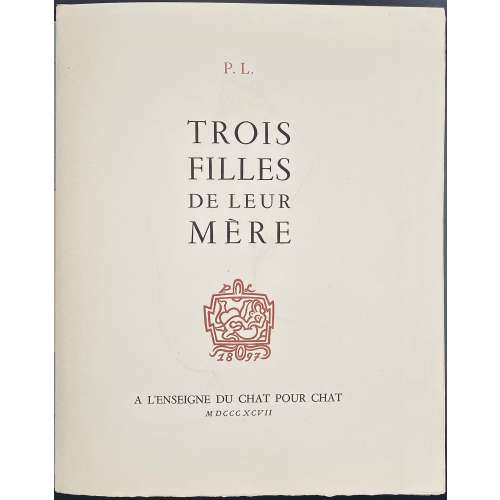 Description: Softcover, original blue-grey wrappers, maroon fleuron to front wrapper « P.L. {copulating couple} 1897. », 28.5 x 23 cm, in a grey double slipcase. Pp.: [1-10] 11-192 [2] [6 blanks], total 200 pages, 50 folio leaves folded in half collated in 4to, unbound, plus 16 coloured lithographs by Jean Berque; all printed on wove paper watermarked “LANA”. This is № 207 of an undisclosed number of copies. Edition enriched with a suite of 12 hand-coloured etchings after Éduard Chimot for publication in the late 1940s (Dutel 2524) on BFK Rives paper. Title-page (maroon and black): P. L. | TROIS | FILLES | DE LEUR | MÈRE | {fleuron} | A L'ENSEIGNE DU CHAT POUR CHAT | M DCCC XCVII || Catalogue raisonné: Dutel 2523, Pia 1340. Contributors: Pierre Louÿs (French, 1870 – 1925) – author. Jean Berque (French, 1896 – 1954) – artist. Édouard Chimot (French, 1880 – 1959) – artist.
Description: Softcover, original blue-grey wrappers, maroon fleuron to front wrapper « P.L. {copulating couple} 1897. », 28.5 x 23 cm, in a grey double slipcase. Pp.: [1-10] 11-192 [2] [6 blanks], total 200 pages, 50 folio leaves folded in half collated in 4to, unbound, plus 16 coloured lithographs by Jean Berque; all printed on wove paper watermarked “LANA”. This is № 207 of an undisclosed number of copies. Edition enriched with a suite of 12 hand-coloured etchings after Éduard Chimot for publication in the late 1940s (Dutel 2524) on BFK Rives paper. Title-page (maroon and black): P. L. | TROIS | FILLES | DE LEUR | MÈRE | {fleuron} | A L'ENSEIGNE DU CHAT POUR CHAT | M DCCC XCVII || Catalogue raisonné: Dutel 2523, Pia 1340. Contributors: Pierre Louÿs (French, 1870 – 1925) – author. Jean Berque (French, 1896 – 1954) – artist. Édouard Chimot (French, 1880 – 1959) – artist. -
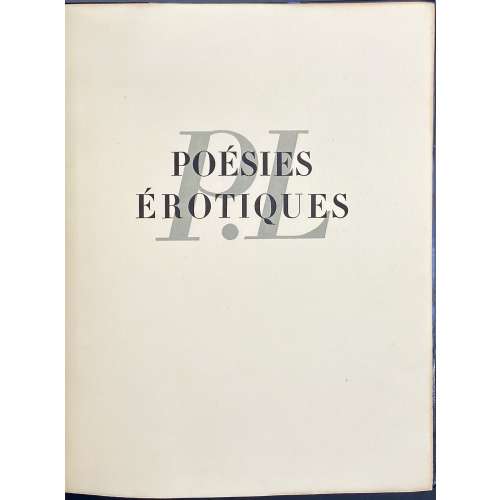 Hardcover volume, 26.6 x 21.3 cm, ¾ blue crushed morocco over marbled boards, marbled endpapers, original wrappers preserved, raised bands; wove paper, watermarked Van Gelder Zonen, unpaginated, 2 ffl, 1 front cover, 2 blanks, 1 h.t., 1 t.p., 46 leaves of text and plates (18 full-page and 14 half-page lithographs by Marcel Vertès), 1 colophon, 1 blank, 1 back cover, 2 ffl; 52 leaves within the original covers, as per Dutel. Title-page: POÉSIES | ÉROTIQUES | D' | UN | AUTE | UR CÉ | LÈBRE, | ILLUSTRÉ | ES DE TR | ENTE-DEUX | LITHOGRAPHIES | ORIGINALES | DESSINÉES | PAR UN | ARTISTE | INCON | NU | ★ | BARCELONE | ATARAZANAS (BARRIO CHINO) | L'AN I DE LA RÉPUBLIQUE | CATALANE || Limitation: A print run of 165 numbered copies, of which this is copy № 148, and 5 additional presentation copies. The text was printed by Massol, and plates were produced by Mme Duchatel. Catalogue raisonné: Dutel III № 2228 ; Nordmann II (Christie’s) № 321; Éros invaincu № 92, p. 222; Vokaer № 36, p. 16. Contributors: Pierre Louÿs (French, 1870 – 1925) – author. Marcel Vertès [Marcell Vértes] (Jewish-Hungarian-French, 1895 – 1961) – artist. René Bonnel (French, 1884 – 1975) – publisher.
Hardcover volume, 26.6 x 21.3 cm, ¾ blue crushed morocco over marbled boards, marbled endpapers, original wrappers preserved, raised bands; wove paper, watermarked Van Gelder Zonen, unpaginated, 2 ffl, 1 front cover, 2 blanks, 1 h.t., 1 t.p., 46 leaves of text and plates (18 full-page and 14 half-page lithographs by Marcel Vertès), 1 colophon, 1 blank, 1 back cover, 2 ffl; 52 leaves within the original covers, as per Dutel. Title-page: POÉSIES | ÉROTIQUES | D' | UN | AUTE | UR CÉ | LÈBRE, | ILLUSTRÉ | ES DE TR | ENTE-DEUX | LITHOGRAPHIES | ORIGINALES | DESSINÉES | PAR UN | ARTISTE | INCON | NU | ★ | BARCELONE | ATARAZANAS (BARRIO CHINO) | L'AN I DE LA RÉPUBLIQUE | CATALANE || Limitation: A print run of 165 numbered copies, of which this is copy № 148, and 5 additional presentation copies. The text was printed by Massol, and plates were produced by Mme Duchatel. Catalogue raisonné: Dutel III № 2228 ; Nordmann II (Christie’s) № 321; Éros invaincu № 92, p. 222; Vokaer № 36, p. 16. Contributors: Pierre Louÿs (French, 1870 – 1925) – author. Marcel Vertès [Marcell Vértes] (Jewish-Hungarian-French, 1895 – 1961) – artist. René Bonnel (French, 1884 – 1975) – publisher. -
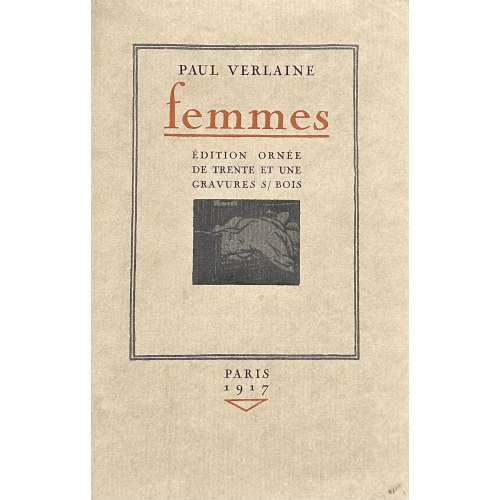 Softcover, 258 x 166 mm, publisher’s olive French flapped wrappers in owner’s glassine dustcover, edges untrimmed, some pages uncut, printed on thick wove paper with watermark “Hollande van Gelder Zonen”, in a slipcase. Pp.: [1-10] 11-129 [5], pages in wrappers included in the count, total 67 leaves; two-tone woodcuts by Jean-Gabriel Daragnès within the pagination. Title-page (red and black, in a double-fillet frame): PAUL VERLAINE | femmes | ÉDITION ORNÉE | DE TRENTE ET UNE | GRAVURES S/ BOIS | {vignette} | (under the bottom frame) PARIS | 1917 | {red triangle} || Limitation: Il a été tiré de cet ouvrage : 11 15 Exemplaires sur vieux papier de Japon numérotés de I à XV; 15 20 Exemplaires sur papier de Chine numérotés de XVI à XXXV; auxquels on a joint une suite des fumés sur même papier. 250 Exemplaires sur papier vélin de Hollande Van Gelder Zonen numérotés de 1 à 250. Après le tirage les bois ont été détruits. № 1. Numbers “15” and “20” corrected manually by Daragnès (per Dutel). This is copy № 1 of vélin de Hollande print run. Catalogue raisonné: Dutel II: № 295; Nordmann II № 544. Seller’s description: Un volume broché in-8° sous couverture illustrée et rempliée. Etui cartonné. Illustré de 31 gravures sur bois en camaïeu, attribuées à DARAGNES, la plupart très libres, dont 18 à pleine page. Tiré à [226 ou 285] ex. numérotés. 1 des [200 ou 250] sur Hollande Van Gelder Zonen. Le nôtre porte le n°1. (Dutel : 295. Pia : 501. Carteret : IV, 392 : Belle édition rare, très estimée ». Monod : 11086). Dorgelès commenta ainsi ces illustrations : « Dans ces nus voluptueux et tragiques, qui semblent à la fois s’aimer et se haïr, on retrouve la même frénésie amère qui tourmente les poèmes interdits de Verlaine » (in Catalogue de livres... Daragnès, Drouot 1924, n°55). Très rares rousseurs. TRES BON EXEMPLAIRE, toujours recherché. Contributors: Paul Verlaine (French, 1844 – 1896) – author. Jean-Gabriel Daragnès (French, 1886 – 1950) – artist/publisher.
Softcover, 258 x 166 mm, publisher’s olive French flapped wrappers in owner’s glassine dustcover, edges untrimmed, some pages uncut, printed on thick wove paper with watermark “Hollande van Gelder Zonen”, in a slipcase. Pp.: [1-10] 11-129 [5], pages in wrappers included in the count, total 67 leaves; two-tone woodcuts by Jean-Gabriel Daragnès within the pagination. Title-page (red and black, in a double-fillet frame): PAUL VERLAINE | femmes | ÉDITION ORNÉE | DE TRENTE ET UNE | GRAVURES S/ BOIS | {vignette} | (under the bottom frame) PARIS | 1917 | {red triangle} || Limitation: Il a été tiré de cet ouvrage : 11 15 Exemplaires sur vieux papier de Japon numérotés de I à XV; 15 20 Exemplaires sur papier de Chine numérotés de XVI à XXXV; auxquels on a joint une suite des fumés sur même papier. 250 Exemplaires sur papier vélin de Hollande Van Gelder Zonen numérotés de 1 à 250. Après le tirage les bois ont été détruits. № 1. Numbers “15” and “20” corrected manually by Daragnès (per Dutel). This is copy № 1 of vélin de Hollande print run. Catalogue raisonné: Dutel II: № 295; Nordmann II № 544. Seller’s description: Un volume broché in-8° sous couverture illustrée et rempliée. Etui cartonné. Illustré de 31 gravures sur bois en camaïeu, attribuées à DARAGNES, la plupart très libres, dont 18 à pleine page. Tiré à [226 ou 285] ex. numérotés. 1 des [200 ou 250] sur Hollande Van Gelder Zonen. Le nôtre porte le n°1. (Dutel : 295. Pia : 501. Carteret : IV, 392 : Belle édition rare, très estimée ». Monod : 11086). Dorgelès commenta ainsi ces illustrations : « Dans ces nus voluptueux et tragiques, qui semblent à la fois s’aimer et se haïr, on retrouve la même frénésie amère qui tourmente les poèmes interdits de Verlaine » (in Catalogue de livres... Daragnès, Drouot 1924, n°55). Très rares rousseurs. TRES BON EXEMPLAIRE, toujours recherché. Contributors: Paul Verlaine (French, 1844 – 1896) – author. Jean-Gabriel Daragnès (French, 1886 – 1950) – artist/publisher.


